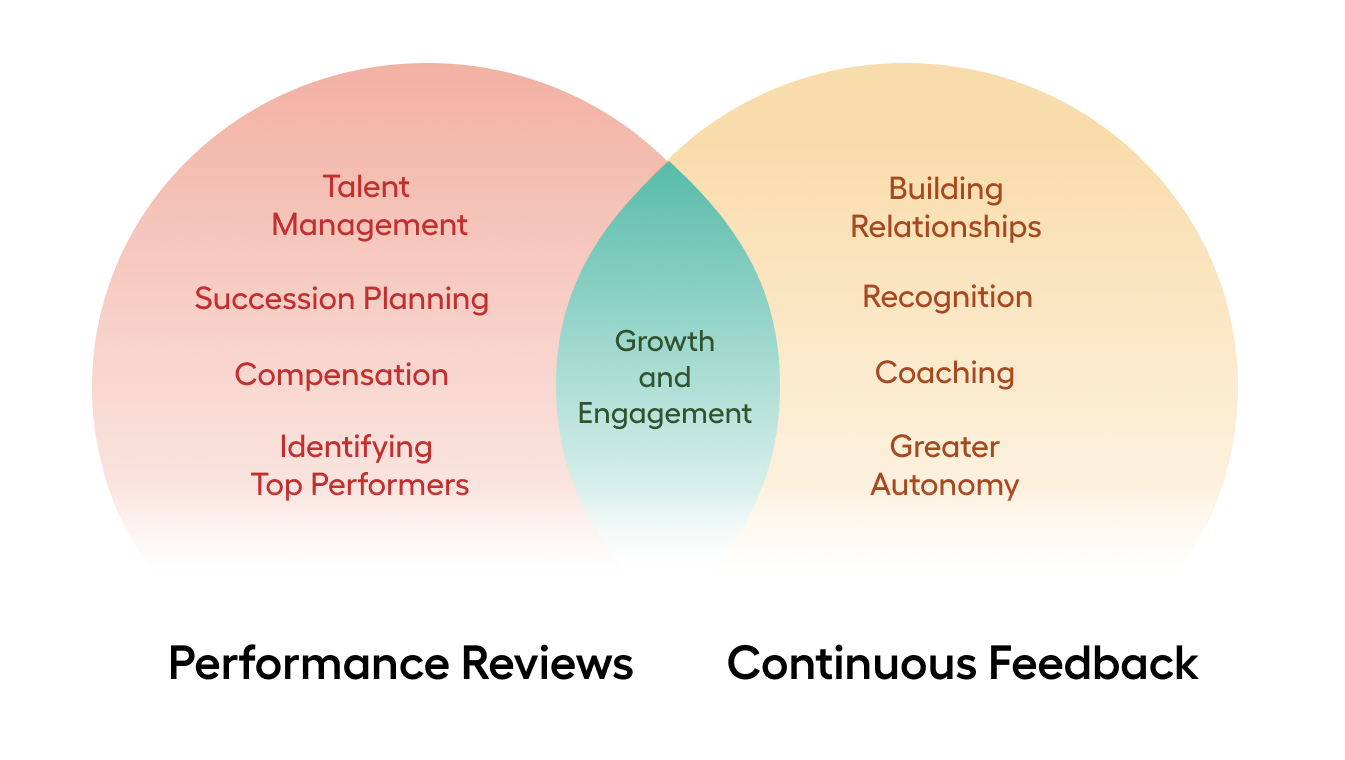A survey conducted by Adobe has revealed that a quarter of all men, and one in five women, have been driven to tears by their annual performance review. It’s no wonder that nearly 90% of HR leaders believe that annual appraisals don’t produce accurate results. In fact, research by Gallup found that one in three employees are so disheartened by a negative performance review, they start job-hunting.
Faced with this evidence, it might seem logical to abandon traditional performance reviews. And many companies have done exactly that. Accenture, Adobe, and GE have eliminated annual appraisals altogether.
However, scrapping the yearly performance review system can come at a serious cost. A formal appraisal system is an excellent weapon against systemic prejudice in the workplace. Without a performance management process in place, line managers are forced to rely on gut instinct — which, no matter how well-meaning the manager, is likely to be riddled with innate bias.
Instead, we’d argue for better, more frequent performance reviews, coupled with a culture of ongoing feedback. Here’s how to create such a high-performance culture — without getting out the Kleenex.
So, is the annual appraisal dead?
HR professionals have been announcing that the annual appraisal is dead for years. However, it seems that rumours of its demise have been greatly exaggerated. According to Inc.com, up to 70% of businesses still use some form of annual performance review to manage employee feedback.
HR leaders are divided on whether the annual appraisal should be thrown out, or simply revamped. For Heidi Scott, Chief Learning Officer at HR.com, it may be time for a complete replacement.
“Should the annual appraisal be dead?” Scott asks. “Perhaps. We have developed and now use a process called CASCADE. This stands for: Conversation about Skills, Career, and Developmental Excellence. Basically, it means exactly what those words say! My team and I have regular conversations about their skills and where they want to go in their careers, and I simply ask how I can help them further develop. Also, by knowing where they want to go in their careers and what their strengths are, I am able to offer learning opportunities that are fitting and appropriate for each person on my team.”
However, for Terese Korsgaard Christensen, Lead HR Consultant at Ørsted, the case against annual appraisals is less clear cut. She argues that, in some companies, the annual appraisal may be appropriate — but not as the only form of performance management.
“The annual appraisal is dead in that it doesn’t make sense only to meet once per year (or twice for that matter),” says Christensen. “The world is constantly changing and so are a company’s needs and priorities, and therefore also those of the individual. With that being said, I still believe that in some company cultures it can make sense to keep the annual wheel. The important thing is that we accept that it can’t stand alone. It needs to be followed up by several conversations throughout the year.”
How can you make yearly performance appraisals more effective?
If you decide to keep the annual appraisal system in place, what should you do to make it more helpful, and less upsetting, for your employees? Here are a few suggestions:
1. Increase the cadence.
We surveyed 1,200 professionals, evenly split between direct reports and managers, to find out the relationship between performance reviews and employee engagement. We found that direct reports’ engagement levels are strongly correlated to performance review frequency. Quarterly reviews lead to higher engagement scores than semi-annual reviews. Semi-annual reviews, in turn, yield higher engagement scores than annual reviews. As shown below, while engagement among managers isn’t as affected by review cadence, the pattern holds.

Given the dramatic impact that employee engagement can have on everything from employee retention to company profitability, it seems that more regular performance reviews would be worth the additional time and effort. Quarterly appraisals might be too time-consuming for many companies, but we’d recommend at least a semi-annual performance cycle.
2. Build a culture of continuous feedback.
Continuous feedback is an ideal complement to a more formal employee appraisal process. In a feedback culture, there is an emphasis on open and ongoing communication between employees and managers. Paige Arnof-Fenn, the Founder & CEO of global branding consultancy Mavens & Moguls, believes that this level of communication between employees and managers is vital to creating a high-performing business.
“Collaboration is key to our culture of engaging our team and ultimately our success,” she says. “I try to set the tone upfront with one rule: ‘When in doubt, over-communicate.’ If the lines of communication are open and everyone makes an effort to listen and be heard, then collaboration will happen naturally and the information will flow.”
In addition to this open exchange of feedback, continuous feedback also entails regular goal-setting conversations, ongoing constructive feedback, and frequent employee recognition in both a formal and informal sense.
Research conducted by Gallup during the pandemic lockdowns in March 2021 found that this approach to performance management, which they called “fast feedback”, was fundamental to maintaining employee engagement during the crisis. The data showed that 84% of employees who had received feedback on their performance during the previous week, described themselves as engaged, as opposed to just 22% of those who had not received any feedback.
It’s important to note that continuous feedback and annual appraisals needn’t be an either-or proposition. At Lattice, we’ve noticed that performance management leaders often use a hybrid approach, blending ongoing performance feedback with formal appraisals.

3. Consider your unique company culture.
When designing a performance appraisal programme, it’s vital to consider your company culture, your employees’ preferences, and your talent management priorities. Terese Korsgaard Christensen cautions HR leaders against “following the trends, instead of understanding the culture of their business when it comes to working with performance and development.”
Christensen’s employer, the global green energy company Ørsted, was recently featured in the Harvard Business Review for its innovative approach to employee development. As she explains:
“At Ørsted, we have decided to keep most of our annual processes. We are an engineer-heavy company, and I often hear people say that engineers typically prefer systems and structures, which the annual processes provide. Instead, we focus on how to build on them, so they match better with our focus on a continuous performance development culture. That way, when managers and employees meet in the annual conversations they can say: ‘We don’t need this conversation, because we are talking performance and development the whole time anyway.’”
In other words, employees should never be surprised by what comes up in their performance reviews. If they are receiving continuous, real-time feedback, and having regular one-to-one development conversations with their managers, employees should know what to expect in their annual appraisals. Without these additional processes in place, appraisals can be highly stressful and demotivating, causing employees to shut down instead of proactively engaging with the feedback they receive.
4. Focus on future performance.
For Christensen, the key to updating Ørsted’s performance management processes has been to encourage managers to consider future potential over past performance issues. “Previously they were much more backward-looking,” she explains. “We wished to redesign to make them more focused on how to develop.”
While acknowledging past performance is important, keeping the conversation focused on how employees can grow and develop will increase their engagement with the conversation.
5. Address bias.
It’s critical not to let bias creep into your performance management system. Without appropriate checks in place, the annual appraisal process can become rife with biases. These can include:
- Recency bias: Our tendency to rely exclusively on our most recent observations
- Similarity bias: When managers favour the employees who are most similar to them
- Gender bias: When female employees are more likely to receive negative feedback based on personality traits, such as “abrasive,” than their male colleagues
Of particular concern, especially in the new normal, is proximity bias. This is a tendency for managers to rate employees who work in the office as more diligent or productive than those working from home.
To correct the potential for bias in annual appraisals, try to include more standardisation and structure. For example, explicitly define performance criteria for each role, and use structured feedback forms to deliver employee feedback. If you need some inspiration, here’s an Annual Performance Review Conversation template we’ve developed at Lattice.
6. Include peer reviews.
Lattice data shows that between 30% and 40% of our high-performing clients include a peer review process in their annual appraisals. This is unsurprising, especially as companies adapt to new ways of working post-COVID. The small, self-organising, and self-directed teams that sprung up to help negotiate the shift to hybrid and remote work during the pandemic lend themselves perfectly to a peer-review approach.
One tip: if you decide to include peer reviews in your annual appraisal process, consider allowing employees to nominate the raters they want feedback from. It can shave a full day off your review cycle.
7. Train managers to give better feedback.
Don’t assume that your managers know how to conduct a helpful appraisal conversation.
According to statistics collated by career site Zippia, employees are extremely enthusiastic about feedback — 75% think that feedback is valuable, while 65% would like more of it. 92% of respondents agree that negative feedback, when delivered appropriately, is effective at improving performance.
With all this positivity about workplace feedback, it would seem reasonable to assume that appraisals would be generally well-received. Yet just 14% of employees believe that their performance review inspired them to improve.
It seems logical that many managers are failing to use performance appraisals to deliver useful performance feedback. Research bears this out. For instance, managers tend to avoid giving negative feedback, even though many employees consider it more helpful than praise. To help ensure that both employees and their employers get more out of their annual appraisal meetings, it may be wise to offer managers training in how to give their teams concrete, specific feedback.
8. Make sure you’re using the right software.
Many companies use their Human Resources Information System (HRIS) to manage the performance review cycle. However, while it can be tempting to try to consolidate your human resource management tools as much as possible, an HRIS is not usually suitable for managing employee performance. Many have a complex user experience more suitable for People administration functions. Ineffective performance software can be frustrating for managers and add to their administrative burden. It leaves them little time to consider their team’s performance in any kind of depth.
In particular, hybrid teams must ensure they have the right tools in place to build an equitable and engaging performance appraisal system, and help managers to conduct meaningful performance conversations with remote and in-office employees alike.
It’s past time for HR to reimagine performance appraisals.
The yearly performance review is not dead. In fact, it may matter now more than ever. With the right measures in place, formal annual appraisals can help to counteract bias in the performance management process, instil a growth mentality, and increase employee engagement.
However, annual appraisals alone are not enough to create a high-performing culture. The yearly employee performance management cycle should be supplemented by a continuous feedback programme. To be effective, a performance management system must ensure that employees receive constructive feedback — and regular positive recognition for their efforts — on a regular basis, not just once or twice a year.
It’s also vital that HR teams acknowledge their unique company culture, and adapt performance review processes to accommodate their employees’ and managers’ preferences and priorities. Feedback must be specific, concrete, and explicit — and even negative feedback is welcome if delivered appropriately. Managers may require training to feel comfortable giving the kind of input that their teams will find useful. However, effective annual appraisals will more than repay the investment.







